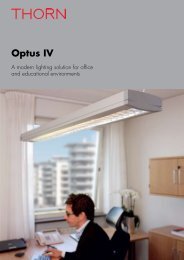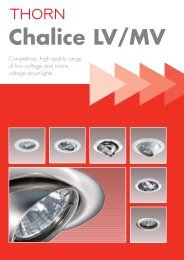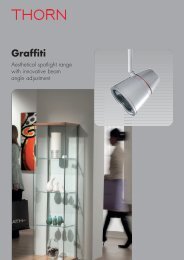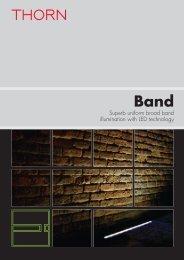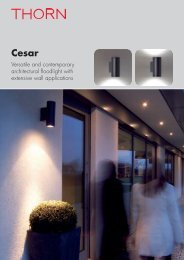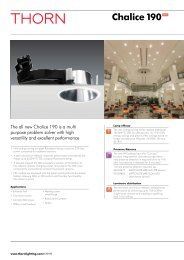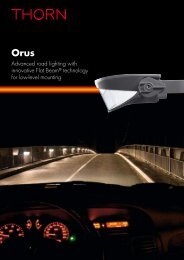Light Distribution - Thorn Lighting
Light Distribution - Thorn Lighting
Light Distribution - Thorn Lighting
You also want an ePaper? Increase the reach of your titles
YUMPU automatically turns print PDFs into web optimized ePapers that Google loves.
<strong>Light</strong> distribution categories<br />
Categorizing of luminaires due to their light distribution:<br />
<strong>Light</strong> distributions of luminaires are categorized by a three character code.<br />
One letter followed by 2 numbers. eg: A10<br />
At first the total lumen light output distribution from each luminaire must be divided in:<br />
- the lower area Ф L<br />
- the upper area Ф U<br />
upper area Ф U<br />
Luminaire<br />
Luminaire mounting level<br />
lower area Ф L<br />
Now Ф L and Ф U must be considered in relation to the total light output Ф T from the<br />
luminaire in all directions.<br />
Ф L<br />
That means φ L = ———<br />
Ф T<br />
Ф U<br />
and φ U = ———<br />
Ф T<br />
<strong>Thorn</strong> <strong>Light</strong>ing, bk LDC-classes_TL-EN.doc Page 1 of 3
<strong>Light</strong> distribution categories<br />
Herewith a first classification Table 1 is possible for the first letters:<br />
1. Figure φ L φ U<br />
A 0,9 ≤ φ L < 1,0 0 ≤ φ U ≤ 0,1<br />
B 0,6 ≤ φ L < 0,9 0,1 ≤ φ U ≤ 0,4<br />
C 0,4 ≤ φ L < 0,6 0,4 ≤ φ U ≤ 0,6<br />
D 0,1 ≤ φ L < 0,4 0,6 ≤ φ U ≤ 0,9<br />
E 0 ≤ φ L < 0,1 0,9 ≤ φ U ≤ 1,0<br />
Now the part light output Ф LT which falls on a standardised task area below the luminaire<br />
must be calculated in relation to Ф L<br />
Ф LT<br />
That means φ LT = ———<br />
Ф L<br />
Herewith a second classification Table 2 is possible:<br />
2. Figure φ LT<br />
0 -<br />
1 0 < φ L ≤ 0,3<br />
2 0,3 < φ L ≤ 0,4<br />
3 0,4 < φ L ≤ 0,5<br />
4 0,5 < φ L ≤ 0,6<br />
5 0,6 < φ L ≤ 0,7<br />
6 0,7 < φ L ≤ 0,8<br />
7 0,8 < φ L ≤ 0,9<br />
8 0,9 < φ L ≤ 1,0<br />
And the part of the light output Ф UC which falls on a standardised ceiling area above the<br />
luminaire must be calculated in relation to Ф U<br />
Ф UC<br />
That means φ UC = ———<br />
Ф U<br />
Herewith a third classification Table 3 is possible:<br />
3. Figure φ UC<br />
0 -<br />
1 0 < φ UC ≤ 0,5<br />
2 0,5 < φ UC ≤ 0,7<br />
3 0,7 < φ UC ≤ 0,9<br />
4 0,9 < φ UC ≤ 1,0<br />
<strong>Thorn</strong> <strong>Light</strong>ing, bk LDC-classes_TL-EN.doc Page 2 of 3
<strong>Light</strong> distribution categories<br />
Class Categories:<br />
With “LDC-class” the light distribution characteristic is defined. The SIA-Norm 380/4<br />
summerises the various classes into 10 categories:<br />
Class <strong>Distribution</strong> Direct light Example<br />
A10-A32 wide 100% Recessed luminaire<br />
A40-A44 medium 100% Recessed luminaire<br />
A50-A80 narrow 100% Recessed luminaire<br />
B21-B22 wide 75% Pendant luminaire<br />
B31-B33 normal 75% Pendant luminaire<br />
B41-B63 narrow 75% Pendant luminaire<br />
C11-C33 wide 50% Pendant luminaire<br />
C42-C63 medium to narrow 50% Pendant luminaire<br />
D11-D63 all 25% Free standing luminaire<br />
E02-E73 very wide 0% Indirect luminaire<br />
The selected LDC-class influences the room utilization factor: as wider the distribution, as<br />
darker the room and as lower the direct part as lower the room utilization factor; this<br />
means that more light has to be installed to reach the required illuminance.<br />
<strong>Thorn</strong> <strong>Light</strong>ing, bk LDC-classes_TL-EN.doc Page 3 of 3




